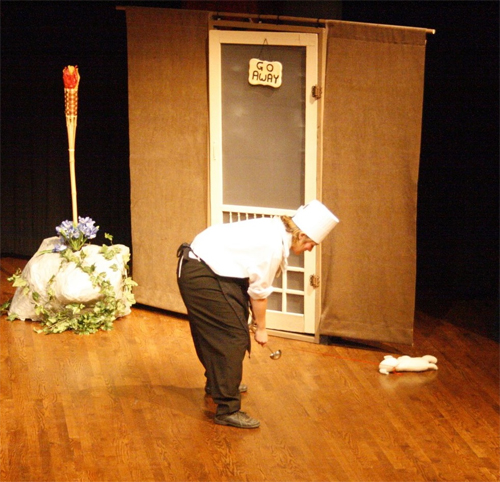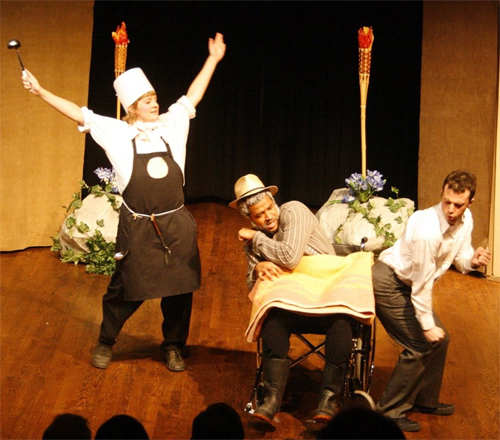A Man Who Hates People
Translated and Adapted from Menander’s Dyskolos by George Kovacs
January 27-February 5, 2011
Performed by the Trent Drama Group
First People’s Performance Space, Nozhem Theatre, Trent University
Ignatieff Theatre, Trinity College, University of Toronto
Review by Donald Sells
University of Toronto

Nick Zawadzski as Sostratus and Christine Gilbert-Harrison as Kore
photo: G. Kovacs

Julianna Will as Sikon
photo: G. Kovacs

Julianna Will as Sikon, Gilbert Enenajor as Knemon, and Steve Donovan as Getas
photo: G. Kovacs
Under the steady guidance of George Kovacs, the Trent Drama Group has added another feather to its cap with its 2011 production of The Man Who Hates People, an adaptation of Menander’s Dyskolos. Last year’s production of Aristophanes’ Wasps was a riotous success which showcased both the TDG’s unique talent and Kovacs’s bold choices in humor and choreography. But Old Comedy and New Comedy are very different animals. While the former’s no-holds-barred slapstick and raunchiness tend to recommend it to the tastes of modern audiences, the New Comedy of Menander presents a special set of challenges for the director who must entertain the same audience with its comparatively restrained, subtle brand of humor.
From the play’s opening moments one could sense a degree of continuity between Man and last year’s production. The dainty and aristocratic Sostratus, played as an ascot-wearing fop by Nick Zawadzski, recalled the deliciously pompous Bdelucleon of Jordan Kripp (who plays Gorgias in Man). Knemon, ‘the man who hates people,’ was superbly played by Gilbert Enenajor, whose greying sideburns and beard, combined with farmer’s suspenders and boots, endowed the crusty old misanthrope with just a whiff of Southern nobility. Indeed, most of Kovacs and Barb Smith’s costuming choices seemed to use the timeless clothing conventions of the rural South to emphasize the social hierarchies of Menander’s people. Man’s primary class collision between the modest farmer Knemon and the wealthy family of Sostratos seemed conceived as a meeting between the New England prep school and poor Southern farmers: Sostratos’ aristocratic pedigree was reflected by a tweed jacket and scarf (or ‘shawl’ according to the script), while Knemon and Gorgias looked the part of agricultural laborers. Kore (Christine Gilbert-Harrison), the farmer’s daughter, was virginal and demure in a dress and straw hat.
The arrangement of the set followed the traditional staging of Dyskolos: two houses on each side of a shrine to Pan and the nymphs. The shrine was located at the back-center behind curtains, while another set of curtains, perpendicular to the first, represented the direction of the countryside on the right. The left wing of the stage was the eisodos from Athens. The farmers’ houses were two ramshackle structures, whose prominence on the Ignatieff stage had the effect of repeatedly signalling the dominant trait – aggression – of the play’s most dominant character, Knemon. Although sturdy, Knemon’s simple house had an especially rickety front door which crashed around its frame with each passage, vividly underscoring the fearsomeness of its occupant. Man, like Dyskolos, has multiple comic door-knocking scenes, and the sounds of entrances and exits were shrewdly exploited to measure Knemon’s growing rage.
Props were few but effectively deployed. Sostratos’ struggle with the Ace Hardware-grade shovel (Act III) was amusing, but Sikon’s entrance with the sheep to be slaughtered for the sacrifice to Pan was arguably the most original piece of physical comedy in the entire play. In Act II, Julianna Will emerged from the left as the cook, dragging a raggedy stuffed animal with a piece of twine to the front-center of the stage. What really made this gag work was Will’s red-faced straining, vividly suggestive of a hernia suffered at some point in rehearsals.
This leads me to a great strength of Man Who Hates People, the distribution of roles. Kovacs has an eye for spreading his talent around in order to capitalize on his actors’ particular strengths. This practice enlivened at least one of the less-exciting roles, that of Getas, which will be described below. Although most of the actors did a fine job, I have space here to comment only on a few.
I have already mentioned Enenajor in the role of Knemon. Enenajor’s ability to fill space very quickly and commandingly is notable. An actor playing a part as aggressive as this must be careful not to run out of room or run over the other actors. Enenajor’s Knemon might be described as an interesting combination of Redd Foxx and a Shakespearean monarch, and convincingly radiated the concentrated rage of the figure of the text. Kovacs’s decision to cast his only other actor of comparable height in the part of Sostratos (Zawadzski) actually communicated a central theme of the play. The greater size of these two actors not only sharpened the social and ethical contrast between the embittered farmer and the dapper youth; it also gave the overarching social concerns of Menander’s play a certain physical dimension, visually reinforcing the two positions between which the maiden would be exchanged in order for Athenian social barriers to be sufficiently overcome.
Jordan Kripp’s earnestness as a Quakeresque Gorgias was amusing and at times reminiscent of his performance as Bdelucleon in Wasps. Will’s Sikon was also very funny: in a modern chef’s outfit the cook became almost cartoonish and even cross-generic, the fat-pads which expanded Will’s stomach and rear – realistically jiggling as she waddled around onstage – adding a nice Aristophanic touch to the excellent physical comedy of her interactions with Knemon.
Menander’s Getas is amusing but perhaps not hilarious. Kovacs skilfully enlivened this part, not a big one in the text, by giving it to his most comically talented actor, Steve Donovan. If readers remember last year’s Wasps, they will definitely recall Donovan’s hysterically funny portrayal of Philocleon. Donovan has the rare ability to entertain with both speech and gesture, and his Jim Careyesque movements are attention-grabbing enough to make any comic role more interesting. I cannot imagine a better rendition of the cathartic final mockery of Knemon than that provided by him and Wills, who were given complete freedom to taunt and harass the old boy in tag-team fashion. Their jubilant exit – with Donovan leaping and clicking his heels – punctuated an excellent production with an explosive and frenetic closure worthy of even Aristophanes.
One particular directorial decision in Man deserves to be singled out: Kovacs’s treatment of the choral interludes, which were not choreographed dances but brief vignettes of metatheatrical joke-telling by the ‘chorus of revellers’ worshipping Pan. Jokes were adapted from sections of Philogelos’ ‘Laughter-Lover,’ an ancient joke-book dated by some to the fourth century CE. I imagine that the decision to stage joke-telling in a style very similar to stand-up comedy charmed some audience members while turning others off. Either way, Kovacs’s choice is to be commended as a highly original solution to a difficult problem of fourth-century comedy, the absence of choral song. The choreutai jovially strutted in and out along a short path lined with rocks and torches through the curtains representing the shrine. The metatheatricality of the four interludes openly acknowledged the audience and sharply contrasted with the preservation of dramatic illusion which generally (but not exclusively) characterizes the action of New Comedy. In the parodos, the worshippers openly pondered the reason for their presence in a style of comedy which has no use for them: is their part being written as they speak – the leader asks – or is the chorus speaking as the director writes? Almost like Aristophanic parabaseis, but without the agonistic element, Kovacs’s interludes openly identified him as a voice behind the chorus. But they were not all sophistication and cleverness: moments after the choreutai identify themselves as revellers, choreut number three drunkenly fell on his face. The audience laughed; the fall was effective.
The chorus’ full purpose in the play is only discovered after the leader produces the Joke Book (a nice concretization of the play’s aim). In each interlude each choreut had a turn to tell a joke, and a drum brought onstage punctuated the delivery of the punch lines. Audience members might disagree about the effectiveness of the metatheatrical comedy, but it succeeded overall: jokes which were actually funny (‘That slave you sold me has died,’ a man complained to another. ‘Well, I swear by all the gods, he never did anything like that when I had him!’) got laughs, and jokes which were not funny (“An egghead went for a dip and almost drowned. As a result, he swore never to go near the water again before first learning how to swim.”) were bad enough that they also got laughs. Kovacs thus demonstrated what many see as a fundamental truth about comedy: bad jokes, if correctly delivered, are always funny. Part of the amusement of these vignettes was observing the efforts of individual choreuts to remain in character when telling some of their appallingly bad jokes.
Rumor has it that next year the Trent Drama Group may return to tragedy – the special field of Desmond Conacher, in whose honor the TDG performs – since Attic comedy has been staged for the past two years. It seemed clear that the audience of students, faculty, and members of the Toronto community who assembled at the George Ignatieff Theater would be only too happy to see the Group continue its successful run of comedy, especially under the guidance of the current director.
